Tomato Troubles: Cultural Practices to Combat Insects and Diseases
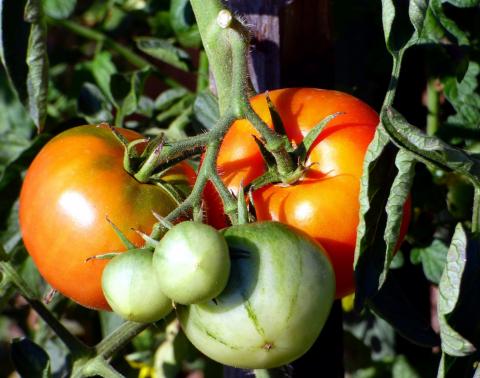
Some years it seems like we grow more insects and diseases than we grow tomatoes. This season can be different if you learn to recognize the symptoms and signs of a few of the worst culprits and use proven strategies to prevent and manage them.
Insect Pests
Hornworms
Hornworms are the larvae of large moths. Adult moths usually lay their eggs on tomato plants in July or August, and the larva hatch shortly thereafter. Of the two species that exist in New Hampshire, the tobacco hornworm is the usual culprit chewing on our tomatoes. Adult moths deposit small eggs on the underside of foliage. After several days, the eggs hatch into tiny caterpillars, which begin feeding on tomato foliage. Unchecked, these pests can grow into 3-5 inch long, green, tomato leaf eating machines. Masters of camouflage, they blend in perfectly with tomato foliage. Left alone, hornworms will eat entire leaves, small stems and even immature fruit.

Management Practices
The most important defense against hornworms is careful surveillance, beginning in early July. Look on the underside of foliage for small, green-white eggs. As the hornworms grow and begin feeding, you will notice holes in the foliage. Look for dark spherical frass (excrement) on the tops of leaves and the ground.
Fortunately, hornworms are easily removed by hand. Although somewhat gross, picking off hornworms can be quite satisfying! Once removed, worms can be squished, dropped into a container of soapy water, or fed to chickens.
A biological insecticide, Bacillus thuringiensis (B.t.), can be used on foliage and is both safe and effective. Sprayed on tomato leaves, B.t. only kills actively eating worms, and does not kill eggs.
Parasitic Apanteles wasps offer a natural biological control, although the process is not quick. These tiny beneficial wasps lay eggs inside the bodies of hornworms, a process that will eventually kill them. You can tell if this is occurring by the presence of tiny white wasp cocoons on the backs of the hornworms. Because the killing is slow, hornworms should still be removed and placed away from the tomato plants in hopes of sparing the wasps.
Potato Flea Beetles
Flea beetles are small jumping menaces. These tiny beasts can fly and are especially damaging to young tomato plants. Early in the growing season, eggs are laid at the base of plant stems and the larvae feed on plant roots. Adult beetles, which grow up to 1/6 inch long, chew on foliage, causing characteristic small, irregular “shot hole” lesions. New leaves are especially affected and can become so damaged, they take on a lacy appearance. In young plants, growth can be stunted, and with serious infections, plants die. Older, established plants can usually tolerate the damage and will survive potato flea beetle feeding.
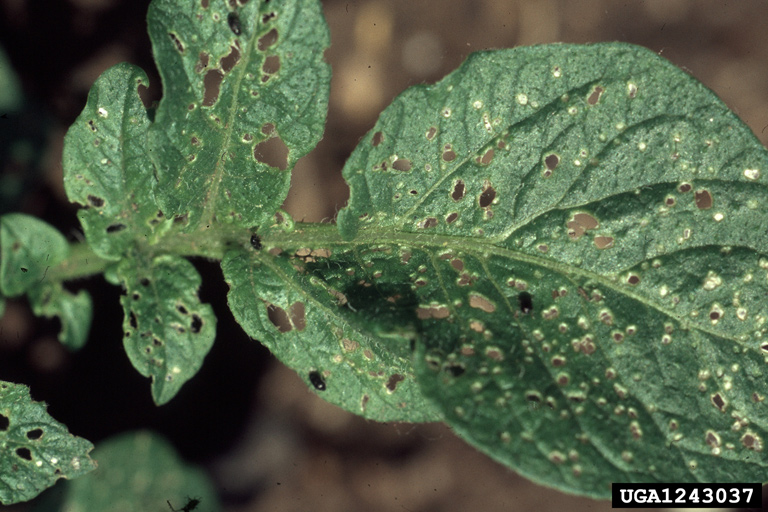
Management Practices
Because flea beetles are so mobile, infestations can be very difficult to control.
Row covers can be used to prevent infestation but must be applied immediately after transplanting. Because adult beetles can overwinter in the soil, thick mulches may help to prevent adults from reaching the plants.
Serious infestations may require the use of insecticides. Some insecticides that can be used to combat flea beetles include: acetamiprid, permethrin, malathion, carbaryl, cyfluthrin, spinosad, and pyrethrins. Of these, spinosad and pyrethrins, in certain formulations, are acceptable for organic gardening. Additionally, Kaolin clay (Surround) is an organic substance that can be used as a repellant. Before using any insecticide, be sure that tomatoes are listed on the label and carefully follow the label directions.
Cutworms
There are many species of cutworms, the larvae of which damage seedlings and transplants. Most cutworms are dark brown, gray or black and are 1-2 inches in length. These scoundrels typically attack early in the season. Some species feast on roots while others bore holes into plant stems, causing the plants to fall over. Other cutworm species climb stems to feed on leaves and buds. Because cutworms work the night shift, they may be missed but you can find them curled up in the soil, napping during the day.
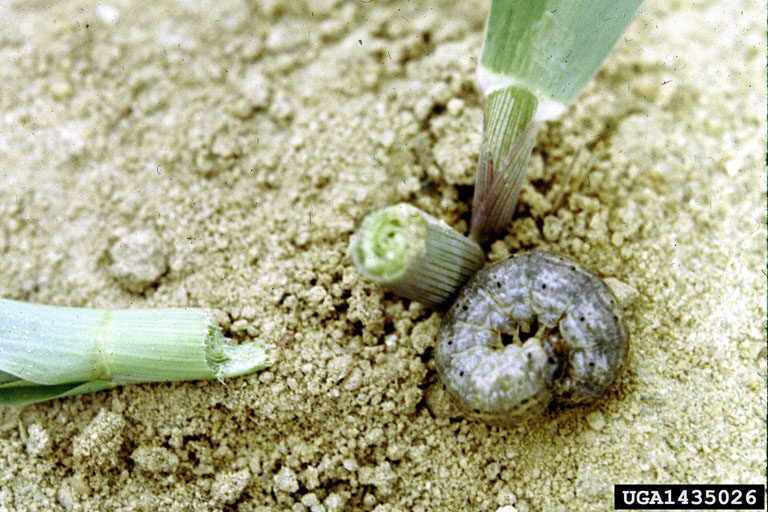
Management Practices
Again, vigilance is key. When discovered, cutworms can be picked off by hand. Look for them by digging a bit at the base of the plant. To keep them off your plants, use stiff plant collars. Collars can be made of cardboard, (paper cups, milk cartons) plastic or metal and should be at least 3 inches high and buried one inch deep around each plant stem.
Other controls include the use of beneficial nematodes or diatomaceous earth or crushed eggshells around the base of plants can help to kill or deter cutworms. Chemical control options include cyfluthrin, permethrin, or carbaryl, applied either as bait or as a foliar spray for cutworms that feed above the ground. Aim to apply chemicals in the evening, shortly before cutworms emerge to start feeding.
Finally, always practice good sanitation by removing tall grasses and weeds that may harbor cutworm larvae.
Fungal Diseases
Fungi that overwinter in the soil are major garden problems. With the exception of late blight, which comes in on weather, early blight, Septoria leaf spot, and Anthracnose can survive the winter on infected plant debris. Surveillance is the key to managing these diseases. Watch for them when the weather is warm (75°F to 80°F) and conditions are humid, damp, or wet, especially for extended periods. Symptoms include leaf spots, rots and wilts.
Anthracnose
Anthracnose, a fungus affecting ripe fruit, manifests as circular water-soaked spots with black fungal structures in the center of the lesions.
.jpg)
Early Blight
Early blight can infect both foliage and fruit. On tomato foliage, circular irregular black or brown spots appear initially on older leaves. These lesions enlarge to form dark concentric rings in a target-like fashion. Untreated, leaves will turn yellow and drop. Total defoliation of the plant is possible. Similar lesions appear on infected fruit.
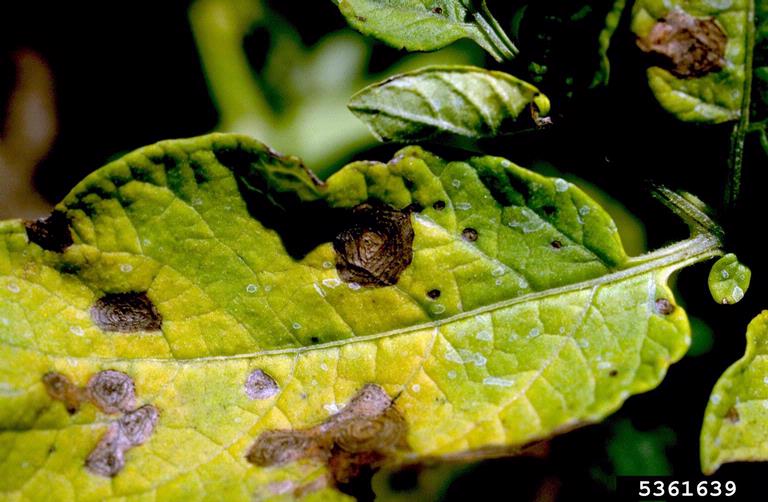
Septoria Leaf Spot
Septoria leaf spot initially infects older leaves and stems. Leaf spots have a dark brow edge with a white or gray center. In time, areas around the spots will turn yellow and the foliage will wither and die. Spread can be rapid and can result in total defoliation.
.jpg)
Late Blight
Late blight also appears initially on older leaves and stems. Leaves develop dark brown patches that result in sections of dried, dead foliage. Dark brown lesions can also from on stems on fruit. In moist weather, a white fungal fuzz, may appear on infected tissue.
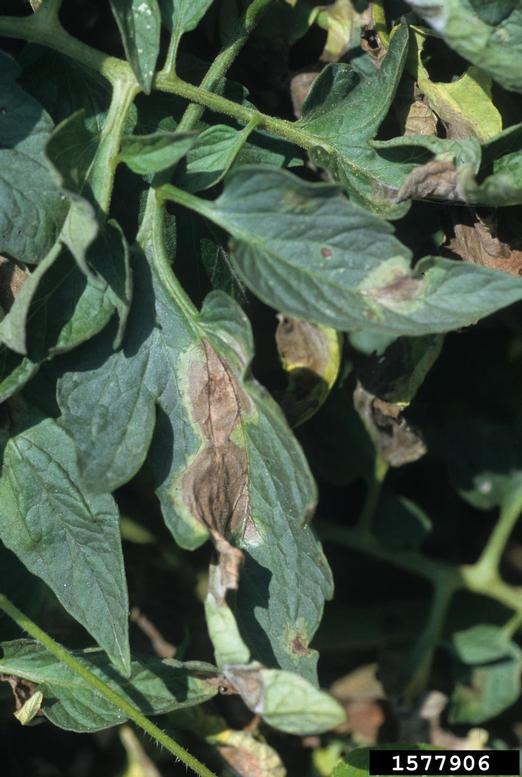
Management Practices for Tomato Fungal Diseases
Early morning watering is a cultural practice that allows foliage plenty of time to dry. Another is watering at the base of the plants, as opposed to overhead watering, to avoid leaving wet leaves that are inviting to fungi.
Similarly, avoid working with plants after a rain since fungi spread easily in wet conditions. Fungal spores can spread to plants from your hands, clothing and tools.
Since fungal spores can overwinter in old plant debris, after harvest in the fall, remove debris. Avoid composting this debris unless you are sure your compost is hot enough to kill spores.
Crop rotation is an essential practice in preventing a buildup of fungal diseases. For example, plant tomatoes in a different location at least every three years. Tomatoes, eggplants, potatoes and peppers should be planted away from one another since all have similar disease problems.
Mulching is yet another practice that can help prevent fungal infection by keeping soil from splashing onto foliage. Mulch can be organic or non-organic. Organic mulch includes straw, pine needles, leaves and compost. Apply between 2-4 inches depending on the mulching material. Benefits of organic mulch include moisture retention, weed suppression and the slow release of nutrients. Inorganic mulch such as black plastic suppresses weeds, retains moisture and warms the soil.
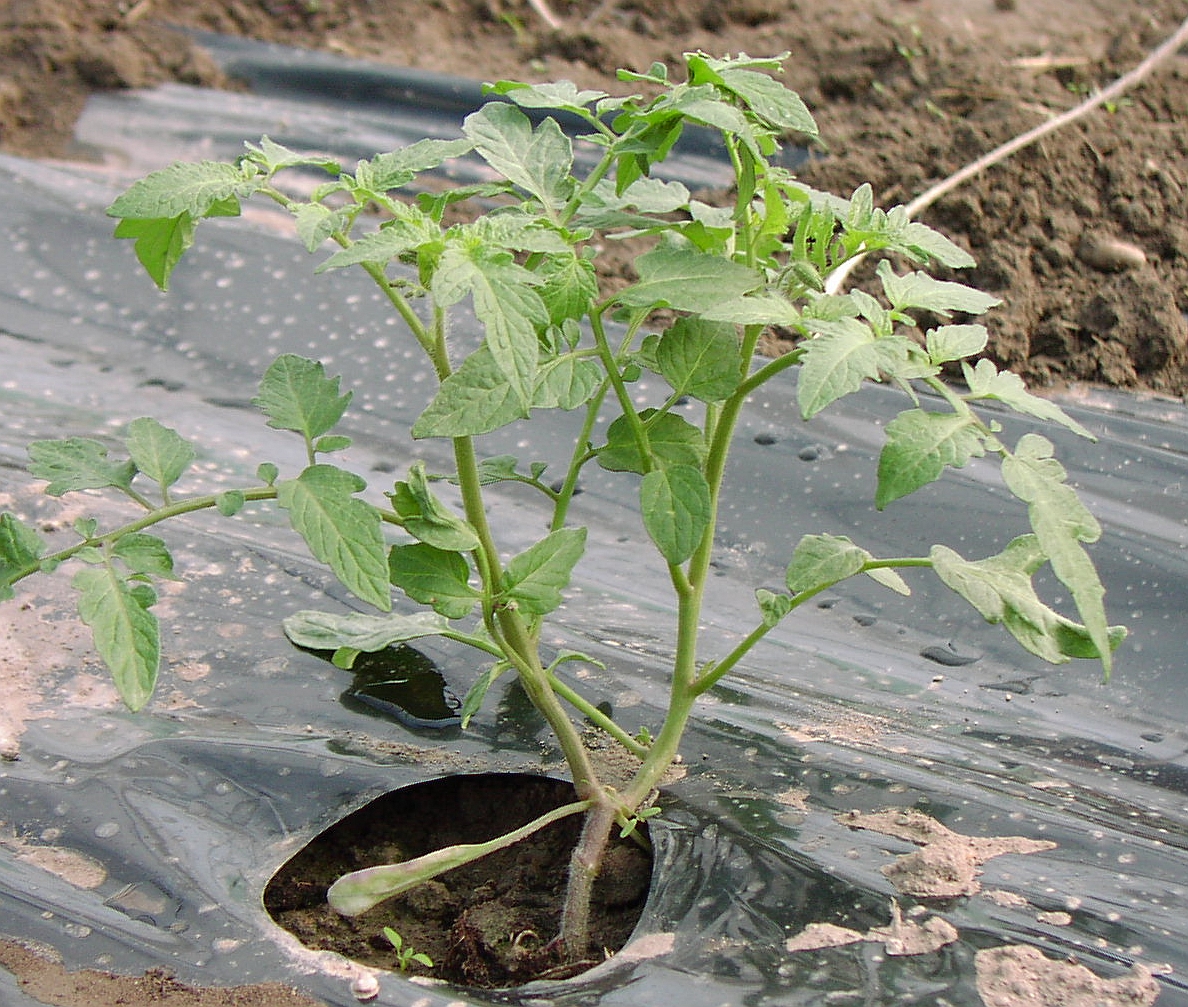
This season, you can make efforts to ensure your tomatoes are healthy and productive. With a little know-how and a fair amount of surveillance, you can fight those tomato insects and diseases and reap the rewards!
UNH Cooperative Extension Master Gardener volunteers share information about home, yard, and garden topics with the people of New Hampshire. Got questions? Master Gardeners provide practical help finding answers to your questions through the Ask UNH Extension Infoline. Call toll free at 1-877-398-4769, Monday to Friday, 9 a.m. to 2 p.m., or e-mail us at answers@unh.edu.
Related Resource(s)
Do you love learning about stuff like this?
SUBSCRIBE TO Granite State Gardening newsletter
Got questions? The UNH Extension Yard and Garden Infoline offers practical help finding answers for your yard and garden questions.
Call toll free at 1-877-398-4769, Monday to Friday, 9 a.m. to 2 p.m., or fill out webform.


